Abstract
For many domains aesthetic appreciation has proven to be highly reliable. Evaluations of facial attractiveness, for instance, show high internal consistencies and impressively high inter-rater reliabilities, even across cultures. This indicates general mechanisms underlying such evaluations. It is, however, also obvious that our taste for specific objects is not always stable—in some realms such stability is hardly conceivable at all since aesthetic domains such as fashion, design, or art are inherently very dynamic. Gaining insights into the cognitive mechanisms that trigger and enable corresponding changes of aesthetic appreciation is of particular interest for psychologists as this will probably reveal essential mechanisms of aesthetic evaluations per se. The present paper develops a two-step model, dynamically adapting itself, which accounts for typical dynamics of aesthetic appreciation found in different research areas such as art history, philosophy, and psychology. The first step assumes singular creative sources creating and establishing innovative material towards which, in a second step, people adapt by integrating it into their visual habits. This inherently leads to dynamic changes of the beholders— aesthetic appreciation.
Keywords: aesthetic processing, art and vision, model, adaptation, preference, liking, dynamics
1. Theory
1.1. Introduction
Research in the wide field of empirical aesthetics demonstrates highly reliable and consistent assessments of aesthetic judgments, especially in regard to what we like and what we hate from a visual aesthetic perspective. Most studies investigating the psychological basis of aesthetic judgments have been conducted in the specific domain of the aesthetics of human faces (for a meta-analysis, see Langlois et al 2000; for an overview, see Perrett 2010). We will therefore first inspect the findings and resulting theories in this particular area of aesthetic research to subsequently extend our view to a more general approach of universal psychological principles that are responsible for creating aesthetic preferences. The specific aim will be to develop a model of how and on what basis such aesthetic preferences are susceptible to changes, the so-called “dynamics of aesthetic appreciation” (Carbon et al 2006).
1.2. Shared taste versus personal taste
In the domain of facial attractiveness, studies continuously indicate high internal consistencies (eg, Cronbach's α > .87, Carbon et al 2010) as well as high inter-rater reliabilities of attractiveness ratings (eg, r > .88, Carbon et al 2010; for a meta-analysis, see Langlois et al 2000), even if persons with different face recognition abilities or belonging to different cultures (Perrett et al 1994) or morphological groups (Cunningham et al 1995) are included in the study. When people are asked to simply categorize faces into four different attractiveness groups, even higher inter-rater reliabilities of κ > .97 (Buhlmann et al 2008) are quite common.
A recent paper by Hönekopp (2006) reveals the routine usage of Cronbach's alpha for demonstrating the supremacy of commonly shared aesthetic standards as a misconception. Using new indices for personal versus shared taste based on separate scores for judges and faces, he could demonstrate that both sources account for equally high amounts of explained variance of facial attractiveness. Although this methodological approach stresses the importance of private taste, it still obtains a very high amount of shared taste.
1.3. Evidence for shared taste
Langlois and colleagues (2000) cite several possible explanations for such high amounts of shared assessments of attractiveness, including (a) social expectancy theories proposing social stereotypes created by cultural similarities in standards of attractiveness, (b) fitness-related evolutionary theories assuming that morphological properties are direct indicators of fitness and the probability of reproductive success, (c) theories emphasizing the possibility of assessing the “quality” of genes by mere phenotypical properties (the so-called good genes theory), and (d) theories linked to the theories (b) and (c) raising the point that attractiveness might be an important visual signal in the context of mate selection.
Obviously, for a more comprehensive or even general theory of the dynamics of aesthetic appreciation a mechanism has to be proposed that is relatively independent of a strictly hard-wired, universal biological program that relies on clear and objective properties such as hip measurement, a cue for increased probability of unproblematic child delivery, or the observed health status. Such a general theory should also deal with aesthetic phenomena evoked by consumer products, artworks, or landscapes (the sublime, “Erhabenheit”), which are not necessarily if at all linked to biological advantages. As a matter of principle the above-mentioned “social expectancy theories” (Langlois et al 2000) have the capability to be quite adaptive towards cultural and social circumstances because they are based on the assumptions (a) that cultural norms and experience shape the perception of aesthetic objects and (b) that social stereotypes create their own reality. This adaptive capability conversely lowers the possibility of gaining trans-age and trans-cultural congruency in aesthetic judgments. This, in turn, can hardly be reconciled with results of developmental studies (eg, Johnson and Pittenger 1984; Zebrowitz et al 1993) or cross-cultural studies (eg, Cunningham et al 1995; Maret and Harling 1985; Rhodes et al 2001, 2002) showing high congruency of aesthetic appreciation—at least for biologically relevant stimuli such as faces or bodies. At first glance, this theory also seems to be hardly reconcilable with the fact that even babies show a strong preference for attractive faces (Langlois et al 1991), categorized so by adult experimenters. A closer look, however, reveals that the documented evidence for such cross-cultural and early operating attractiveness universalities is much weaker than often supposed. For instance, there are many indications for culturally dependent aesthetic phenomena such as extreme tattoo practices of the Maori often covering large parts of their bodies and faces or aesthetic optimization by teeth filling, scarification, or massive enlargement of lips or ears (for illustrations, see chapter 6 in Zebrowitz 1997). Additionally, the notoriously reported fact that babies already show the same preferences as adults is rather problematic: first, because only vague indications for attractiveness (eg, habituation-dishabituation paradigms or inspection times) can be used due to a lack of valid verbal responses and, second, because such measures, no matter how valid they are, cannot be compared with rating scale data due to their obviously incommensurable scale quality. Nevertheless, it is undeniable that we share taste with others to a certain degree. But which mechanisms prompt such behaviour exhibited by many people?
1.4. Dynamic change of aesthetic appreciation
It is clear that such a mechanism has to be quite flexible and should not be (exclusively) based on hard-wired processes. This requirement seems mandatory when aesthetic appreciation is analysed in a historical context and not only as a one-off measurement at one specific point of time. Although aesthetic appreciation is a true topic of psychological research, we have to refer to approaches stemming from the context of art history to get deeper insights into the dynamics of specific styles. Art history typically develops theories on how different artistic styles evolved, how they inspired each other, and how they replace out-dated ones. Notwithstanding, art history mainly tries to explain how and sometimes why certain artistic streams emerged, but not whether and why beholders appreciate the objects generated from these streams.
Figure 1 illustrates how similar some of Pierre-Auguste Renoir's masterpieces were in terms of high saturation of the colour blue during his period of work when he visited Italy in the early 1880s. This idiosyncratic period shows a clear difference compared with earlier as well as later styles where he strongly relied on his manner referred to as “diffuse reflection” and “Ingres period”, respectively (Gombrich 2005). Note: It can be assumed that, around the early 1880s, Renoir shifted from the so-called “Cobalt blue”, a cobalt(II) aluminate of pure blue colour that was a very costly and stable pigment, to cheaper and less light-resistant blue pigments; this change can be observed, for example, by closely inspecting the different shades of blue in his painting The Umbrellas (Les Parapluies), painted in the same period. As Bazin (1958) noted already, the highly saturated blue that can nowadays be observed in Renoir's paintings like those shown in Figure 1 might be owed to the aging of these cheap pigments. Even if so, this would indicate that Renoir was reliably using these specific pigments in that creative period which already expressed a specific colour style back to the date of the paintings— origins. With such characteristic usage of specific styles, artists as well as designers create their own brand, which is important to be recognized by and associated with (for art, see Augustin et al 2008; for consumer products, see Kreuzbauer and Malter 2005; Ulrich and Smallwood 2007). Importantly, artists as well as designers often change their style after a while, mostly due to further developing or revolutionizing their techniques by integrating new procedures, changing their themes or the focus of their work in response to new insights and experiences made in the meantime (Panofsky 1955).
Figure 1.

Paintings by Pierre-Auguste Renoir (1841–1919) from a narrow period of time of his artistry show a high consistency of the specific usage of the colour blue. From left to right: (a) Sleeping Girl (1880), (b) Venezia, the Doge's Palace (1881), (c) Bay of Naples, Evening (1881), (d) Child with a Bird (1882). Photographs made by CCC.
The change of style, though, does not necessarily imply a change of aesthetic appreciation for it. For instance, we cannot be sure that Gothic art was preferred to the Romanesque style when it was initially established as a widely known architecture style in the 13th century. It is, nevertheless, highly implausible that a vast majority of people still preferred the ancient style after a while. Instead, processes such as mere exposure (Zajonc 1968) or cognitive mechanisms like understanding and appreciation induced by repeated evaluation (Carbon and Leder 2005; Faerber et al 2010) may have led to an increase of aesthetic appreciation towards certain exemplars frequently available to the beholders.
Although the change in preferences is an important topic of aesthetic research, systematic data on such effects, especially concerning longer periods of time spanning several decades (Cutting et al 2011), are rather sparse. Pioneering psychological research contributing to this topic was conducted by Martindale (1990). In his noteworthy book A Clockwork Muse, Martindale gathered strong evidence for cyclic changes of artistic style in a variety of fields, such as music, visual arts, and poetics. Carbon (2010) replicated the general cyclic character of the evolution of aesthetic dimensions in the area of consumer product design, particularly when referring to the curvature of car exteriors. Importantly, he extended the mere analysis of historical data by testing adaptation mechanisms as a plausible explanation for cyclic changes of appreciation as well. When confronted with highly innovative designs of so-called concept cars, presumably containing many future design features, the participants adapted their aesthetic appreciation towards the style of these designs, while their liking for previously preferred cars introduced over the last 15 years decreased a significant degree. This study demonstrated the power of adaptation towards frequently or, particularly, recently inspected exemplars and the associated style, which is quite compatible with the strong and reliable effects of adaptation in the domain of faces (Rhodes et al 2003). This strong cognitive mechanism of adaptation proved to be very powerful in explaining the shift of prototypes (Carbon 2009; Carbon and Leder 2006; Leopold et al 2005), normality/veridicality assessments (Carbon and Ditye 2011; Rhodes and Jeffery 2006), and preferences (Carbon 2010; Carbon et al 2007; Farber et al 2007; Rhodes et al 2003) and makes it improbable that concepts such as classic aesthetic norms, constant prototypes, or standards of beauty exist at all. Although notions like “timeless design” (Vandenbroecke 1992) or “eternal standards of beauty” (Vitruvius 1999) and even advertisements suggestively propagating high-priced brands that allegedly embody classical perfection and are thus a sign for good taste (Figure 2) imply stability in aesthetic appreciation, such preferences actually seem to be quite flexible. Thus, taking the psychological mechanism of adaptation into account, Gaultier's implication of eternal aesthetic perfection and stable taste shown in Figure 2 seems incorrect.
Figure 2.
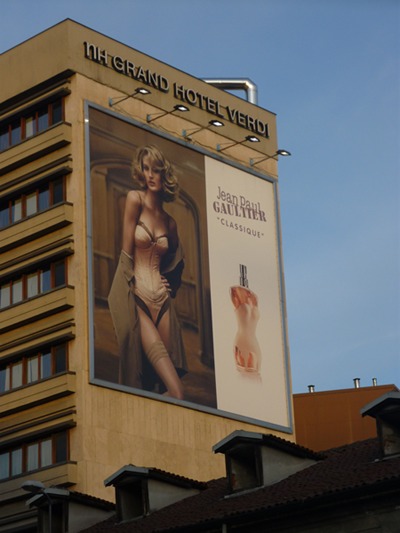
Jean-Paul Gaultier 2011 advertising campaign for the Gaultier perfume brand “Classique”, first introduced in 1993, which directly refers to the concept of “classic” or “eternal” (good) taste comparable to a perfect body shape which stays rather constant. Photograph made by CCC.
Only by assuming a highly flexible mechanism we seem to fit with and adapt to an ever-changing world. Psychological mass phenomena of dynamic changes of aesthetic appreciation, detectable in fashion (Majima 2007), artistic style (Sorokowski 2010) and design (Carbon 2010), and even in body shape (Pettijohn and Jungeberg 2004), documented as very old in cultural history, would be inconceivable if such an adaptive mechanism was not postulated.
1.5. Synchronization of aesthetic appreciation
What we need to explain phenomena of dynamic changes of aesthetic appreciation is a flexible cognitive mechanism that is relatively independent from fixed norms or hard-wired principles. If we analyse the dynamics of aesthetic appreciation over the years, across different object categories and for different aesthetic domains, it becomes quite obvious that we can identify “streams”, “movements”, or “periods”. For instance, art history is mainly concerned with studying objects of art in a historical context by explicitly identifying the developments, the emergence, and the change of stylistic properties. Typically, art history can explain how such changes emerge as a result of political, religious, geographical, or sometimes even of weather-related factors. The adaptation mechanism identified by previous research (eg, Carbon 2010) could be a promising candidate for explaining mass phenomena of changes of aesthetic appreciation towards new design or art features in a simple but psychologically relevant way. People get effectively synchronized in their behaviour and preferences via this mediating adaptation mechanism. Documented phenomena of “desynchronization” of preferences can be concordantly explained with this approach by insufficient or non-existing exchange of information about the objects of desire, for instance, fashion items (Figure 3).
Figure 3.
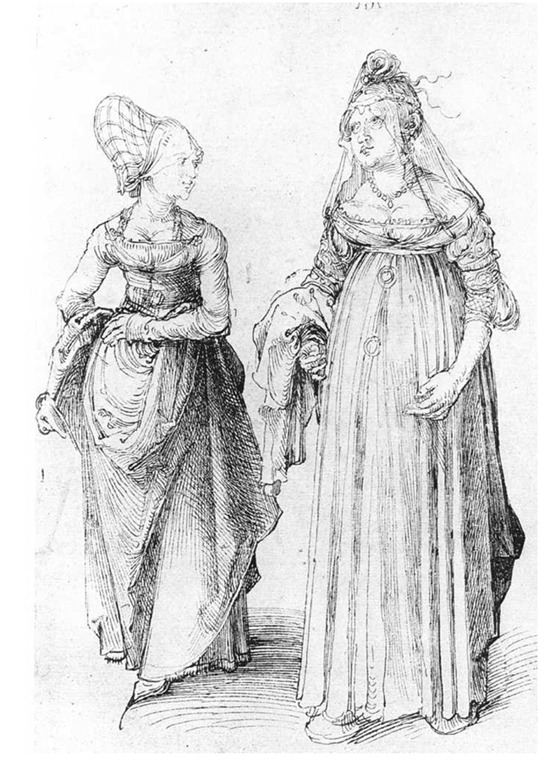
Illustration of desynchronization of fashion styles in former times: The picture shows a drawing by Albrecht Dürer from 1496–1497 depicting a typical style of a bourgeois from Nuremberg (left) and from Venice (right) emphasising long legs by the usage of high chopines plus a skirt cut with the waist edge just beneath the female bust. Source: Wikimedia Commons.
Synchronization, on the other hand, leads to concordant, similar or shared processes of aesthetic appreciation and can even have behavioural consequences as documented by humans— synchronized behaviour when encountering, for instance, depictions of saints or holy persons, producing constant abrasion of certain spots of the artistic objects (Figure 4).
Figure 4.

Detail of the bronze gates of the Duomo di Milano (Milan cathedral; lower part of the Major Door, planned by L Pogliaghi) demonstrating frequent touching of specific parts of the holy scenes, which results in burnishing these parts over the years. The highly selective burnishing indicates synchronized visitors— behaviour, here the touching of the central and significant mutual soft touch of Jesus— and Maria's hands. Photograph made by CCC.
Adaptation also seems to be an elegant way to dissolve some inconsistencies in the literature concerning the degree of shared taste. Vessel and Rubin (2010) have found high amounts of shared taste for real-world images but not for abstract ones. The more abstract an image is the lower is the chance to create associations to objects that we can explicitly refer to. This lowers the possibility of creating an image of such an item—a classical cognitive finding dating back to Paivio (1969). This means that items of high abstractness are also susceptible to being evaluated on a rather idiosyncratic basis without a great chance of being a source of adaptation in a general way. Real-world images, in contrast, are a perfect starting point for such adaptation effects; consequently, they are also potential objects of triggering shared taste.
Beside the mechanism of adaptation being a plausible source of synchronization of aesthetic appreciation, we essentially need a further ingredient for explaining the sources of the changes of artistic style (Augustin et al 2008) or the “Formensprache” (Carbon 2010). Actually, we need a clue for the cognitive principle which triggers innovation itself. Artists and designers belonging to the creative sector evidently have to innovate, or else they will only copy previous work and just prefer (and thus create) what they have already generated due to mere exposure or other familiarity phenomena (Martindale et al 1988). Martindale (1990) solves the problem by assuming inherent conservatism on the side of typical beholders (see Carbon and Leder 2005), but high innovative power and flexible taste on the side of the artists (Martindale 1994). Such trendsetters can start a period of synchronization with a more conservative audience just as illustrated by Figure 5. What are probable candidates for the compulsion of creating and innovating things? First, people often get bored by too familiar exemplars after a while, a phenomenon ascribed in the 19th century by Göller (1888), which he termed “Formermüdung” (form fatigue); second, creative people compete with each other, creating ongoing innovations; third, partly nonconscious, adaptation to innovative and distinctive parts from other cultures, domains, or exemplars re-shaping the creative one's visual habits themselves.
Figure 5.
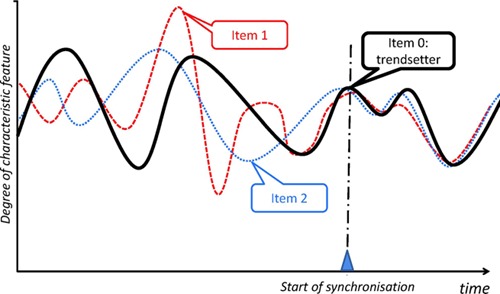
Model of trendsetters triggering starting points of synchronisation: From a certain point of time, the characteristic feature, which can vary among many different aspects such as material, form, colour, etc, indicated by “Item 0” which is generated by a highly creative and publicly renowned trendsetter is appreciated via adaptation. Competing items (works of art, consumer products, design) oriented towards this innovative feature, even copying or imitating it, increase the availability and consequently the appreciation of the new feature.
Clearly, the feature beholders adapt to varies across different classes of (consumer) products and might, even within one class, change over time; probable candidates for the automobile sector, for example, are colour, shape (Formensprache), and the specific material used. So, over time, the most important feature for which beholders are synchronized can change from, eg, colour to shape and then, some more years later, to material or other design features.
2. General discussion
To sum it up, having adaptation as a basic cognitive mechanism, we are equipped to fulfil many demands of an ever-changing world. By mere exposure to (Zajonc 2001) and, even stronger, by active elaboration (Carbon and Leder 2005) of highly innovative material such as fashion, design, and art objects, we automatically integrate the perceived exemplars into our visual habits. As the compatibility with these visual habits, mostly operationalized by prototypicality (Blijlevens et al in press), is a key factor in explaining aesthetic appreciation, our preferences for such exemplars change dynamically. When different people perceive the same objects iteratively, for instance, because they belong to the cultural canon or refer to frequently promoted products of famous brands, shared preferences for these items will emerge.
Importantly, this mechanism alone can only explain dynamic changes as a reaction to given streams of design or art innovations. Consequently, we have to propose an initial mechanism started by highly creative sources that generate and trigger such trends, taking the role of so-called “innovators” (Rogers 2003). Such sources may be individuals from the creative industries with high publicity, for instance, famous designers or artists, celebrities merely wearing or using such products, or influential events or media presentations such as the Milan design week or a typical trend journal such as “Vogue” promoting innovative goods to a broader mass (Sproles 1981). If we take these two mechanisms together, the first one promoting innovative objects and the second one allowing people to adapt to these innovations, we can explain the often documented high amounts of shared preferences as well as idiosyncratic tastes of desynchronized (sub)cultures. The idea of two subsequent sub-processes leads to a dynamically adapting two-step model of aesthetic appreciation (Figure 6). The result of the whole process will not be the establishment of a final kind of appreciation space, where all the most appreciated exemplars are represented, but only a temporary state which we might call taste. According to this conception, taste is only a kind of retuning or refinement of the previously established “appreciation space” (see Figure 6), which has the power to establish and stabilize our appreciation not longer than for a certain period of time after which new, innovative exemplars will be encountered and, so, start the process again. Essentially, this process is a dynamic one that never reaches full stability, as experience with new stimuli will always start and revive the process again (Carbon 2010). Figure 6 illustrates this two-step model with the historical change in art history from impressionist paintings to post-impressionist/expressionist streams of art.
Figure 6.
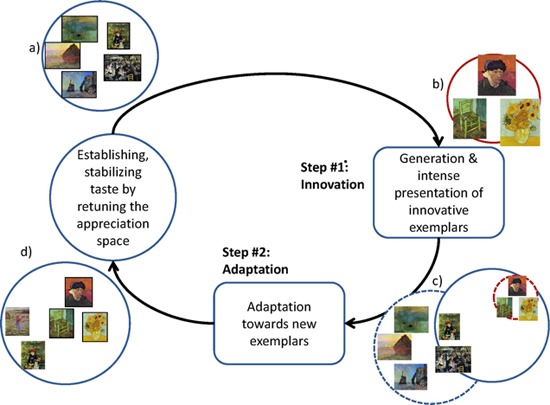
Two-step model of the dynamics of aesthetic appreciation, illustrated with appreciation changing from impressionist to post-impressionist paintings. Taste is (a) established and stabilized until beholders are (b) intensively confronted with innovative exemplars (step #1). In a subsequent adaptation phase (step #2) beholders (c) adapt towards the new stimuli integrating them into their visual habits. The appreciation space is (d) continuously retuned, establishing and stabilizing taste again. Paintings depicted here are from the Wikimedia Commons showing (a) typical impressionist works by Claude Monet and Pierre-Auguste Renoir and (b) distinctive and, in the period of impressionism, highly innovative post-impressionist/expressionist works by Vincent Van Gogh.
With such a cognitive mechanism in mind, we can also understand typical mechanisms moving “fashionista”, people who slavishly follow current fashion trends as they intensively consume fashion media and permanently adapt their taste. Additionally, it is also possible to explain why even elderly people are susceptible to being influenced by design innovation—if they elaborate sources referring to such material (Carbon and Schoormans in press).
3. Conclusions
In conclusion, we should be aware that adaptation is a very helpful mechanism to adjust to a highly dynamic world. It is, though, also a potentially dangerous mechanism that brings us to adapt to ideals we have not chosen on a conscious basis but which change our “Geschmacksapparat” (system for validly assessing our taste) incidentally, without explicit reference. In contrast to Figure 7, which portrays the view of an almighty entity explicitly dictating fashion rules that people have to follow, we seem to be biased much more indirectly, nonconsciously by such a mechanism.
Figure 7.
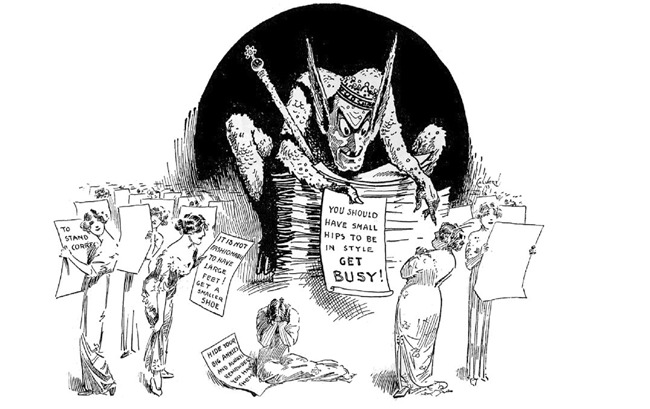
Image is from the Wikimedia Commons, originally from Life magazine from 1913 describing fashion as an evil force which explicitly dictates fashion rules that people have to follow.
Therefore, it does indeed matter which media we consume: whether these media show lean or chubby bodies, attractive or ugly faces, or arousing or calm art—these images will change our aesthetic appreciation, thus our preferences, and consequently, our view onto the world as a whole.
Acknowledgments
I would like to thank M Dorothee Augustin and Johan Wagemans for organising and inviting me to the very inspiring conference “Visual perception and visual arts” held at the Royal Flemish Academy of Belgium for Science and the Arts in November 2010. This conference incorporating vivid discussions with the other speakers was the initial starting point of writing this paper. I also want to express gratitude to Vera M Hesslinger and Andrea Lyman for proofreading the text and to two anonymous reviewers and Johan Wagemans for improving the text.
Biography
Claus-Christian Carbon studied psychology and philosophy at University of Trier, received his PhD in psychology from the Freie Universität Berlin, and his habilitation from the University of Vienna. He is full professor and head of the Department of General Psychology and Methodology at the University of Bamberg, Germany. His research aims to understand the processing of complex objects, particularly faces and works of art, dynamics of aesthetic appreciation and he wants to advance methods of behavioral research.
References
- Augustin M D, Leder H, Hutzler F, Carbon C C. “Style follows content: On the microgenesis of art perception”. Acta Psychologica. 2008;128:127–138. doi: 10.1016/j.actpsy.2007.11.006. [DOI] [PubMed] [Google Scholar]
- Bazin G. Impressionist paintings in the Louvre. London: Thames & Hudson; 1958. [Google Scholar]
- Blijlevens J, Carbon C C, Mugge R, Schoormans J P L. “Aesthetic appraisal of product designs: Independent effects of typicality and arousal”. British Journal of Psychology. in press. [DOI] [PubMed]
- Buhlmann U, Etcoff N L, Wilhelm S. “Facial attractiveness ratings and perfectionism in body dysmorphic disorder and obsessive-compulsive disorder”. Journal of Anxiety Disorders. 2008;22:540–547. doi: 10.1016/j.janxdis.2007.05.004. [DOI] [PubMed] [Google Scholar]
- Carbon C C. “What “exactly” is a prototype? Not sure, but average objects are not necessarily good candidates for…”. Journal of Vision. 2009;9:512–512. doi: 10.1167/9.8.512. [DOI] [Google Scholar]
- Carbon C C. “The cycle of preference: Long-term dynamics of aesthetic appreciation”. Acta Psychologica. 2010;134:233–244. doi: 10.1016/j.actpsy.2010.02.004. [DOI] [PubMed] [Google Scholar]
- Carbon C C, Ditye T. “Sustained effects of adaptation on the perception of familiar faces”. Journal of Experimental Psychology: Human Perception and Performance. 2011;37:615–625. doi: 10.1037/a0019949. [DOI] [PubMed] [Google Scholar]
- Carbon C C, Ditye T, Leder H. “Setting the trend: When attractiveness is a matter of adaptation”. Perception. 2006;35:199–199. doi: 10.1068/p5452. [DOI] [Google Scholar]
- Carbon C C, Gruter T, Gruter M, Weber J E, Lueschow A. “Dissociation of facial attractiveness and distinctiveness processing in congenital prosopagnosia”. Visual Cognition. 2010;18:641–654. doi: 10.1080/13506280903462471. [DOI] [Google Scholar]
- Carbon C C, Leder H. “The Repeated Evaluation Technique (RET): A method to capture dynamic effects of innovativeness and attractiveness”. Applied Cognitive Psychology. 2005;19:587–601. doi: 10.1002/acp.1098. [DOI] [Google Scholar]
- Carbon C C, Leder H. “The Mona Lisa effect: is ‘our’ Lisa fame or fake?”. Perception. 2006;35:411–414. doi: 10.1068/p5452. [DOI] [PubMed] [Google Scholar]
- Carbon C C, Leder H, Ditye T. “When style matters. Art-specific adaptation effects”. Perception. 2007;36:17–17. doi: 10.1068/p5467. [DOI] [PubMed] [Google Scholar]
- Carbon C C, Schoormans J P L. “Rigidity rather than age as a limiting factor to appreciate innovative design”. Swiss Journal of Psychology in press. [Google Scholar]
- Cunningham M R, Roberts A R, Wu C H, Barbee A P, Druen P B. “Their ideas of beauty are, on the whole, the same as ours: Consistency and variability in the cross-cultural perception of female physical attractiveness”. Journal of Personality and Social Psychology. 1995;68:261–279. doi: 10.1037/0022-3514.68.2.261. [DOI] [Google Scholar]
- Cutting J E, Brunick K L, DeLong J E, Iricinschi C, Candan A. “Quicker, faster, darker: Changes in Hollywood film over 75 years”. i-Perception. 2011;6:569–576. doi: 10.1068/i0441aap. [DOI] [PMC free article] [PubMed] [Google Scholar]
- Faerber S J, Leder H, Gerger G, Carbon C C. “Priming semantic concepts affects the dynamics of aesthetic appreciation”. Acta Psychologica. 2010;135:191–200. doi: 10.1016/j.actpsy.2010.06.006. [DOI] [PubMed] [Google Scholar]
- Farber S, Carbon C C, Leder H. “From exposure to evaluation: Dynamic changes in appreciation of innovative designs”. Perception. 2007;36:17–17. doi: 10.1068/p5598. [DOI] [PubMed] [Google Scholar]
- Göller A. Entstehung der architektonischen Stilformen [The development of architectural stylistic forms] Stuttgart: K Wittwer; 1888. [Google Scholar]
- Gombrich E H. The Story of Art. London: Phaidon; 2005. [Google Scholar]
- Hönekopp J. “Once more: Is beauty in the eye of the beholder? Relative contributions of private and shared taste to judgments of facial attractiveness”. Journal of Experimental Psychology: Human Perception and Performance. 2006;32:199–209. doi: 10.1037/0096-1523.32.2.199. [DOI] [PubMed] [Google Scholar]
- Johnson D F, Pittenger J B. “Attribution, the attractiveness stereotype, and the elderly”. Developmental Psychology. 1984;20:1168–1172. doi: 10.1037/0012-1649.20.6.1168. [DOI] [Google Scholar]
- Kreuzbauer R, Malter A J. “Embodied cognition and new product design: Changing product form to influence brand categorization”. Journal of Product Innovation Management. 2005;22:165–176. doi: 10.1111/j.0737-6782.2005.00112.x. [DOI] [Google Scholar]
- Langlois J H, Kalakanis L, Rubenstein A J, Larson A, Hallam M, Smoot M. “Maxims or myths of beauty? A meta-analytic and theoretical review”. Psychological Bulletin. 2000;126:390–423. doi: 10.1037/0033-2909.126.3.390. [DOI] [PubMed] [Google Scholar]
- Langlois J H, Ritter J M, Roggman L A, Vaughn L S. “Facial diversity and infant preferences for attractive faces”. Developmental Psychology. 1991;27:79–84. doi: 10.1037/0012-1649.27.1.79. [DOI] [PubMed] [Google Scholar]
- Leopold D A, Rhodes G, Mueller K-M, Jeffery L. “The dynamics of visual adaptation to faces”. Proceedings of the Royal Society B: Biological Sciences. 2005;272:897–904. doi: 10.1098/rspb.2004.3022. [DOI] [PMC free article] [PubMed] [Google Scholar]
- Majima S.2007“Generating fashion cycles: The role of international trade fairs since the creative destruction of Parisian Monopoly” Paper presented at the International Business, International Organizations and the Wealth of Nations Conference, Geneva
- Maret S M, Harling C A. “Cross-cultural perceptions of physical attractiveness: Ratings of photographs of whites by Cruzans and Americans”. Perceptual and Motor Skills. 1985;60:163–166. doi: 10.2466/pms.1985.60.1.163. [DOI] [Google Scholar]
- Martindale C. The Clockwork Muse: The Predictability of Artistic Change. New York: Basic; 1990. [Google Scholar]
- Martindale C. “How can we measure a society's creativity?” Dimensions of Creativity. Cambridge, MA: MIT Press; 1994. [Google Scholar]
- Martindale C, Moore K, West A. “Relationship of preference judgments to typicality, novelty, and mere exposure”. Empirical Studies of the Arts. 1988;6:79–96. [Google Scholar]
- Paivio A. “Mental imagery in associative learning and memory”. Psychological Review. 1969;76:241–263. doi: 10.1037/h0027272. [DOI] [Google Scholar]
- Panofsky E. Meaning in the Visual Arts. Garden City, NY: Doubleday; 1955. [Google Scholar]
- Perrett D I. In Your Face: The New Science of Human Attraction. Hampshire, UK: Palgrave Macmillan; 2010. [Google Scholar]
- Perrett D I, May K A, Yoshikawa S. “Facial shape and judgements of female attractiveness”. Nature. 1994;368:239–242. doi: 10.1038/368239a0. [DOI] [PubMed] [Google Scholar]
- Pettijohn T F, Jungeberg B J. “Playboy Playmate curves: Changes in facial and body feature preferences across social and economic conditions”. Personality and Social Psychology Bulletin. 2004;30:1186–1197. doi: 10.1177/0146167204264078. [DOI] [PubMed] [Google Scholar]
- Rhodes G, Harwood K, Yoshikawa S, Nishitani M, McLean I. “The attractiveness of average faces: Cross-cultural evidence and possible biological basis”. Facial Attractiveness: Evolutionary, Cognitive, Cultural and Motivational Perspectives 2002 [Google Scholar]
- Rhodes G, Jeffery L. “Adaptive norm-based coding of facial identity”. Vision Research. 2006;46:2977–2987. doi: 10.1016/j.visres.2006.03.002. [DOI] [PubMed] [Google Scholar]
- Rhodes G, Jeffery L, Watson T L, Clifford C W G, Nakayama K. “Fitting the mind to the world: Face adaptation and attractiveness aftereffects”. Psychological Science. 2003;14:558–566. doi: 10.1046/j.0956-7976.2003.psci_1465.x. [DOI] [PubMed] [Google Scholar]
- Rhodes G, Yoshikawa S, Clark A, Lee K, McKay R, Akamatsu S. “Attractiveness of facial averageness and symmetry in non-western cultures: In search of biologically based standards of beauty”. Perception. 2001;30:611–625. doi: 10.1068/p3123. [DOI] [PubMed] [Google Scholar]
- Rogers E M. Diffusion of Innovations. New York: Free Press; 2003. [Google Scholar]
- Sorokowski P. “Did Venus have long legs? Beauty standards from various historical periods reflected in works of art”. Perception. 2010;39:1427–1430. doi: 10.1068/p6621. [DOI] [PubMed] [Google Scholar]
- Sproles G B. “Analyzing fashion life-cycles: Principles and perspectives”. Journal of Marketing. 1981;45:116–124. doi: 10.2307/1251479. [DOI] [Google Scholar]
- Ulrich D, Smallwood N. “Building a leadership brand”. Harvard Business Review. 2007;85:92–92. [PubMed] [Google Scholar]
- Vandenbroecke F. “A Timeless Office-System + Design-Classic Action-Office”. Design. 1992:64–64. [Google Scholar]
- Vessel E A, Rubin N. “Beauty and the beholder: Highly individual taste of abstract, but not real-world images”. Journal of Vision. 2010;10:1–14. doi: 10.1167/10.2.18. [DOI] [PMC free article] [PubMed] [Google Scholar]
- Vitruvius. Ten Books on Architecture. Cambridge, UK: Cambridge University Press; 1999. [Google Scholar]
- Zajonc R B. “Attitudinal effects of mere exposure”. Journal of Personality and Social Psychology. 1968;9:1–27. doi: 10.1037/h0025848. [DOI] [Google Scholar]
- Zajonc R B. “Mere exposure: A gateway to the subliminal”. Current Directions in Psychological Science. 2001;10:224–228. doi: 10.1111/1467-8721.00154. [DOI] [Google Scholar]
- Zebrowitz L A. Reading Faces: Window to the Soul? Boulder, CO: Westview Press; 1997. [Google Scholar]
- Zebrowitz L A, Olson K, Hoffman K. “Stability of babyfaceness and attractiveness across the life span”. Journal of Personality and Social Psychology. 1993;64:453–466. doi: 10.1037/0022-3514.64.3.453. [DOI] [PubMed] [Google Scholar]


